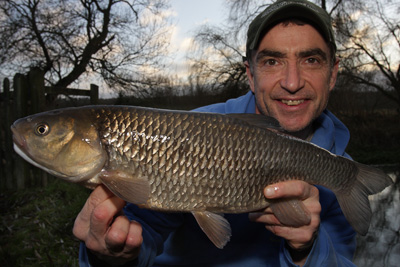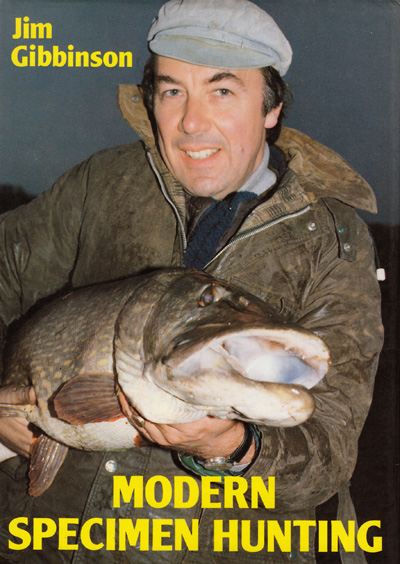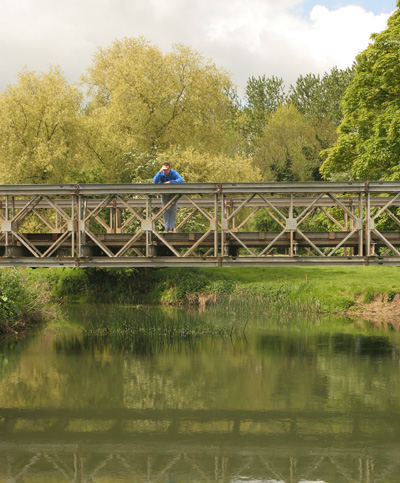“The time has come,” the Walrus said,
“To talk of many things:”
It’s actually Christmas Day as I sit down to write my December ‘Weigh In’ but in the glorious spirit of Scrooge and all of the ‘Bah Humbuggers’ it is not a festival I choose to celebrate. I know and fully respect, however, that most of the readers of FishingMagic probably do, so Merry Xmas!
I am, however, sitting here with a bottle of champagne so this could get messy…
After having a whinge in my last monthly outing that winter, and hence the start of my fishing proper, hadn’t yet arrived I’ve been rather disappointed again in that, so far, we have still only had one night of frost down here and, although conditions have deteriorated somewhat, it’s still not really winter!
 We did, however, have a little bit of rain and with some very mild, low pressure following on from a run of cool nights (and the aforementioned single frost) there was the ‘perfect storm’ as far as barbel fishing was concerned on 22 December when everything was pretty well lined up for a feeding spell.
We did, however, have a little bit of rain and with some very mild, low pressure following on from a run of cool nights (and the aforementioned single frost) there was the ‘perfect storm’ as far as barbel fishing was concerned on 22 December when everything was pretty well lined up for a feeding spell.
I had not fished all month but even I couldn’t resist those conditions and spent four hours that evening beside a local beat of river for a brace of 5lb chub and a barbel of around 8lb. Hardly earth-shattering stuff, but it was nevertheless very nice to be out and the new bait I’ve been working on caught first time out on a new venue, which was quite reassuring!
It has been a terrific month as far as FishingMagic is concerned though and I’ve thoroughly enjoyed the features we have been able to bring you recently; many of them inspired by the writing competition.
In this respect many congratulations to Christian Barker on a well-deserved November competition win for his ‘Winter Chubbing’ feature which got a lot of people talking on the forum. I’ve long been an advocate of the ‘give ‘em enough rope’ method of chub bite detection and to see it written about is all too rare. I have always tended to use a bobbin on a very long drop rather than an open bail arm as such but there is no doubt that in the right circumstances it can make the difference between a fish on the bank and not.
One other little tweak that has caught me quite a few big chub is the way I hook my bait; I very often fish the maggot feeder for chub at this time of year and quite how a bloody big chub can sometimes pick up the very tip of a single maggot in its lips without pricking itself has always amazed me. These days if they are a bit cagey I just side hook the maggot (a single red on a size 18 or 20 usually) and they tend prick themselves every time.
I always enjoy Kevin Perkins’ features and his ‘Heroes and Villains’ piece really made me smile; I’m surprised there were not more member contributions to the categories on the forum but I certainly have to add a couple of my own here.
 As far as heroes are concerned I would have to add Jim Gibbinson; those of a certain age will, perhaps, remember his TV escapades in ‘The Fishing Race’ where, with partner Jim Gillespie, he was fishing for the ‘Golden Maggot’ but there is far more to this delightfully ascerbically-witted Kent angler than many will be aware. His contribution to early carp fishing, for example, was monumental, and often overlooked, but for me it was his 1983 book ‘Modern Specimen Hunting’ which was the inspiration and he, more than Walker, was the one who steered my early specimen angling approach – although Jim himself was, of course, part of the ‘Walker-inspired generation.’
As far as heroes are concerned I would have to add Jim Gibbinson; those of a certain age will, perhaps, remember his TV escapades in ‘The Fishing Race’ where, with partner Jim Gillespie, he was fishing for the ‘Golden Maggot’ but there is far more to this delightfully ascerbically-witted Kent angler than many will be aware. His contribution to early carp fishing, for example, was monumental, and often overlooked, but for me it was his 1983 book ‘Modern Specimen Hunting’ which was the inspiration and he, more than Walker, was the one who steered my early specimen angling approach – although Jim himself was, of course, part of the ‘Walker-inspired generation.’
They say you should never meet your heroes but I would have to disagree on the basis of my few experiences, both in angling and without, and one of my very fondest and most treasured angling memories is a day on the Medway estuary mullet fishing (for that is what he specialises in these days) with Jim. Happy days indeed.
Also missing, for me, is another man of Kent and another angler who made a huge contribution to early carp fishing – Fred Wilton. Fred’s knowledge of bait really is second to none and his ‘Towards the Ultimate Bait’ feature shaped my entire thinking on the subject and my introduction, years later, to his barbel baits just blew my mind. Fred was, and remains, in a league of his own.
My final hero is yet another carp legend – why is it so many of the best big fish anglers were once dedicated carpers? – Sir Pete Springate. I caught up with Pete over far too many glasses of wine earlier this month and he is quietly doing to giant barbel what he once did to giant carp. Legend.
In Kevin’s ‘Jury’s Out’ category my only nomination is the Angling Trust. It is no secret that I am a long-time critic of the organisation but this year, for the first time in my mind, there were signs that they are finally beginning to get their act together and so I’m happy to ‘promote’ them from ‘villain’.
OK so they are ten years too late with ‘Cormorant Watch’ and have, thus far, failed to address the main problem facing anglers (of which more later) but there is progress!
And so to the real villains! Our pastime (it is not a sport) has always attracted more than its fair share of villains – and I’ve been unfortunate enough to have known quite a few of them. At the time of writing I’ve not quite had enough champagne to name them, but the day is young…
In the news features this month a couple of related pieces caught my attention. Firstly the Environment Agency’s stocking of young Calverton barbel into the Rivers Ouse and Ouzel and, secondly, the formation of a new group to highlight the lack of action on otter predation.
I am a great supporter of the work of the EA’s fisheries departments, they do a lot of very good work with the resources they have at their disposal and are not appreciated by many anglers, some of whom simply complain about a ‘waste of their licence money.’ However, the introduction of young barbel into Adams Mill struck me as being very short-sighted and a case, as Richard Bowler commented on the forum, of ‘putting a sticking plaster on a terminally ill patient’.
 My PB barbel is still the ‘Traveller’ from Adams Mill and the loss of this fish – and the rest of the Mill giants – due to otters, was heartbreaking. I welcome the habitat improvement and fish introductions on the Ouse but the river has deep-rooted problems which a few fish will not correct and these young barbel are simply destined to be otter fodder.
My PB barbel is still the ‘Traveller’ from Adams Mill and the loss of this fish – and the rest of the Mill giants – due to otters, was heartbreaking. I welcome the habitat improvement and fish introductions on the Ouse but the river has deep-rooted problems which a few fish will not correct and these young barbel are simply destined to be otter fodder.
Enter the ridiculously named ‘English Carp Defence League’ founded by Mark Holmes to highlight the lack of action in respect of otter predation on primarily carp, but barbel and other species too.
In addition to the loss of the Adams Mill barbel Norfolk’s marvellous Sayers Meadow project has also been hit by otters and the massive habitat improvement work undertaken by the Norfolk Anglers’ Conservation Association over many years appears to have hit an unexpected wall. I’m reliably informed by the likes of respected Oxford angler John Everard that his local rivers have been decimated, ditto with my colleagues on fisheries such as Throop and other southern rivers and my own eyes are now seeing the first double figure barbel carcasses on the Kennet with the tell-tale signs of otter attack.
It’s a difficult subject to attempt to tackle in a short comment piece such as this and much of the ‘evidence’ is anectdotal. As a scientist I’m trained to accept facts, and there are not enough of them to draw definite conclusions in many cases. It is clear, however, that on many of the rivers which have been left devoid of barbel otters were only the final piece in a very complicated jigsaw which saw populations failing to self sustain due to any number of environmental factors including abstraction, discharge, habitat loss etc.
When a river ecosystem is well balanced it can support the predatory pressure an otter brings to bear, when it is on its last legs and the fishery is sustained by a small head of big fish – as many of the aforementioned systems were – the presence of an otter is likely to bring only one conclusion. Sadly the restoration of those rivers in crisis – and there are so many of them – is an expensive and essentially long term project and the presence of otters is in the here and now, short term. It could take a generation – or more – to create balance and that is something we should all be worried about.
We are in somewhat of a Catch 22 situation too: do nothing and some rivers could take a generation to find a predator prey balance (if indeed they do at all); call for action and risk alienating the general public who perceive otters to be cute and cuddly. No wonder some people want to hide their heads in the sand but sorry, this problem is one which is not going to go away.
As far as carp are concerned the picture is just as grim, although many will no doubt mention the essentially ‘manufactured’ environment of many carp fisheries which are stocked above what is considered to be a ‘natural’ fish biomass. But the commercials will, no doubt, deal with the problem just as they did the cormorant by putting effective predator prevention measures in place, leaving the larger and more natural venues to take the brunt of the pressure.
I applaud Mark’s efforts and have gone on the record as supporting the aims – as far as our rivers are concerned anyway – as, in my opinion, anything which helps to highlight the state of our rivers, and in so doing has the potential to bring positive change, has to be a good thing. It is, perhaps, ‘doomed to fail’ as Paul Boote and others have suggested on the forum but when it is something as important as the future of our rivers I for one would sooner try and fail than not try at all…But Mark, for goodness sake, change the name please!
Well, at this juncture I was going to comment on Fred Crouch’s barbel feed feature which has some relevance to this issue. I love Fred dearly and this piece was an interesting mix of fact and fiction but, looking up, I see the champagne bottle is empty so it may have to wait until new year.
Enjoy the festive season!










